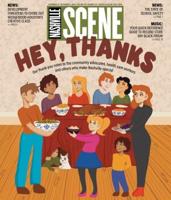
Jason Isbell
There’s an idea in our culture that something new always needs to be happening. We have an obsession with the idea of one-upping ourselves, doing something bigger and better than we’ve done before, charting new territory. But sometimes it’s wisest to follow the old adage: If it ain’t broke, don’t fix it. Jason Isbell and the 400 Unit’s Weathervanes, released June 9 via Southeastern Records/Thirty Tigers, follows a well-established formula — with a few notable alterations. But it’s one that is clearly still working, and Weathervanes joins the group’s catalog as yet another instant classic.
The new LP is Isbell & Co’s longest original work to date — only their covers album Georgia Blue is longer — with a runtime of just over an hour. Four of the 13 tracks last at least five minutes, with the final two songs running more than six minutes each. Long guitar solos pad the ending, wrapping up just short of gratuitous. Miraculously, Weathervanes doesn’t quite overstay its welcome. That’s not to say that the length is earned, but when an artist is as consistent as Isbell, an occasional extended listen is excusable.
Thematically, Weathervanes builds on many of the same ideas as its predecessors. As usual, the songs are a mix of personal confessions and writing exercises in which the songsmith inhabits different narrators. The ability to take on a different perspective is becoming a lost art in today’s musical landscape, with fan culture overtaken by parasocial fantasies and hungry audiences demanding authentic vulnerability. But Isbell knows what not every songwriter seems to understand — stories don’t have to be real to be true. Like many songwriting heroes of the past, the master storyteller is able to spin a tale from any moment, real or imagined, and make it real for each person lucky enough to hear it.
The four tracks released ahead of the album — “Death Wish,” “Middle of the Morning,” “Save the World” and “Cast Iron Skillet” — offer a well-rounded sampler of Weathervanes’ variety of topics and sounds. As the aforementioned cuts hint, the sonic landscape of the whole album is as varied as that of the South, the region that Isbell and the band have always called home and draw significant inspiration from. With Weathervanes, Isbell set out to make his most rock ’n’ roll album since his early days with the Drive-By Truckers. It’s safe to say that he succeeds — fans of Isbell’s easy-listen Americana balladry will find plenty to love here, but the light country melodies are tucked gently between rollicking guitar riffs and stadium-sized anthems.

Jason Isbell and the 400 Unit
The stories wrapped up in the expansive Weathervanes show that Isbell still has his finger firmly on the pulse of working-class America. Standout track “King of Oklahoma” is a shattering portrait of substance abuse, with Isbell mourning, “She used to make me feel like the king of Oklahoma / But nothing makes me feel like much of nothing anymore.” The brooding “When We Were Close” echoes the portrait of Isbell’s early music career painted in his recent HBO documentary Running With Our Eyes Closed, a wild and shadowy mess of high-point performances and deep pitfalls. Isbell’s wife Amanda Shires is not part of the official 400 Unit lineup at present, but her fiddling and fiery but delicate harmonies are once again a highlight of the record, elevating Isbell to a fuller version of his potential. On tracks like the penultimate rocker “This Ain’t It,” he howls at her and she growls back, ever unsatisfied with the state of the world.
Isbell cuts loose a bit on Weathervanes, taking charge of production on his own — not calling on longtime producer Dave Cobb, but bringing in an array of other production and engineering collaborators including Matt Pence, Gena Johnson, Matt Ross-Spang and Sylvia Massy. Fans initially drawn to the more delicate presentation on earlier 400 Unit records might mourn this as a loss, but the change feels like it’s just enough to push Isbell, allowing his familiar themes and lyrical style to take on new life.
The album is a gem of contemporary Southern rock, representing a cadre of records that your grandparents and your kids are likely to agree is “real, good music.” Change, as has been said often, is constant. But knowing what to hold onto is how we find ourselves better on the other side.












